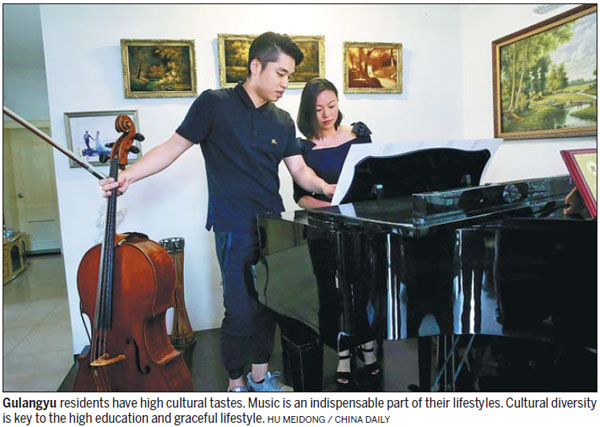

Diversity on the 2-square-kilometer island has produced multitudes of renowned celebrities and leaders in many fields, Yang Cheng reports.
Gulangyu Island, of the coast of Xiamen in Fujian province, is smaller than 2 square kilometers and yet is known as the "magic celebrity islet" home to many of China's leading scholars and celebrities.
Zhan Zhaoxia, executive editor of the Journal of Gulangyu Studies, said cultural diversity is key to the unparalleled number of renowned national contributors that emerged from the island.

"Since the 1920s, 'International Settlement' was carved on tablets on the island and people from Europe, the Americas and Southeast Asia came here, indicating the island is an international community with residents from around the world," Zhan said.
Gulangyu has a strong blend of three cultures: Christianity, Southeast Asian and Minnan from southern Fujian province.
Since residents' childhood in the early part of the last century, the locals have enjoyed the highest levels of musical, sport and English education. The island's Xunyuan, Yude and Yinghua schools were founded by missionaries.
Many residents living on the island early in the 20th century were business titans with thriving Southeast Asian businesses, Zhan said.
During the War of Resistance Against Japanese Aggression (1931-45), when Xiamen was occupied, Gulangyu suddenly saw its population hit 100,000 from 30,000-40,000 previously. The schools on the island kept their doors open for the new refugee children.
Hong Puren, a researcher at the Fujian Culture and History Research Institute, said during the 100 years from the Opium Wars in the mid-19th century to World War II, Chinese and Western cultures blended to create the islet's unique status in science, education and culture.
"The island records the twists and turns of Eastern and Western cultures mixing, and reflects the ups and downs of revolution and reforms in Chinese history. The residents are the shining stars of the last century," Hong said.
Gulangyu recently joined UNESCO's world cultural heritage list, demonstrating its residents' noble spirit and educated background. Its inclusive culture is the key DNA that will pass down for generations to come, he said.
Islanders of note
Lin Yutang (1895-1976), who migrated to the island at the age of 10, is a famous writer, linguist and translator.
The work to compile Lin's Chinese-English Dictionary of Modern Usage was undertaken at the then newly founded Chinese University of Hong Kong. The vast index was published in 1972.
His many works represent an attempt to bridge the cultural gap between the East and the West. Lin was nominated for the Nobel Prize in literature in 1940 and 1950
Lin Qiaozhi (1901-1983) was China's top obstetrician and gynecologist. She revolutionized the modern field in China and blazed new trails for the country. Her research achievements are still honored by China's obstetrics and gynecology circles to this day.
Ma Yuehan (1882-1966) was China's founder of modern sports theory and a professor at Tsinghua University.
Lu Hanzhang (1854-1928) was the founder of China's pinyin system, which is the official phonetic system for transcribing Mandarin pronunciations of Chinese characters into the Latin alphabets on the mainland, Taiwan, and Singapore. It is often used to teach standard Chinese in classrooms across China.
Gulangyu is the birthplace of Zheng Nankun and Zhu Xiaoping, just two of the many noted Chinese scholars at the United Kingdom's Cambridge University.
Thanks to its reputation as an island of music, the island has produced world-level pianists.
Contact the writer at yangcheng@chinadaily.com.cn
|
A view over Gulangyu Island in Xiamen, a coastal city of East China's Fujian province. The islet is on the UNESCO World Cultural Heritage list.Hu Meidong / China Daily |

